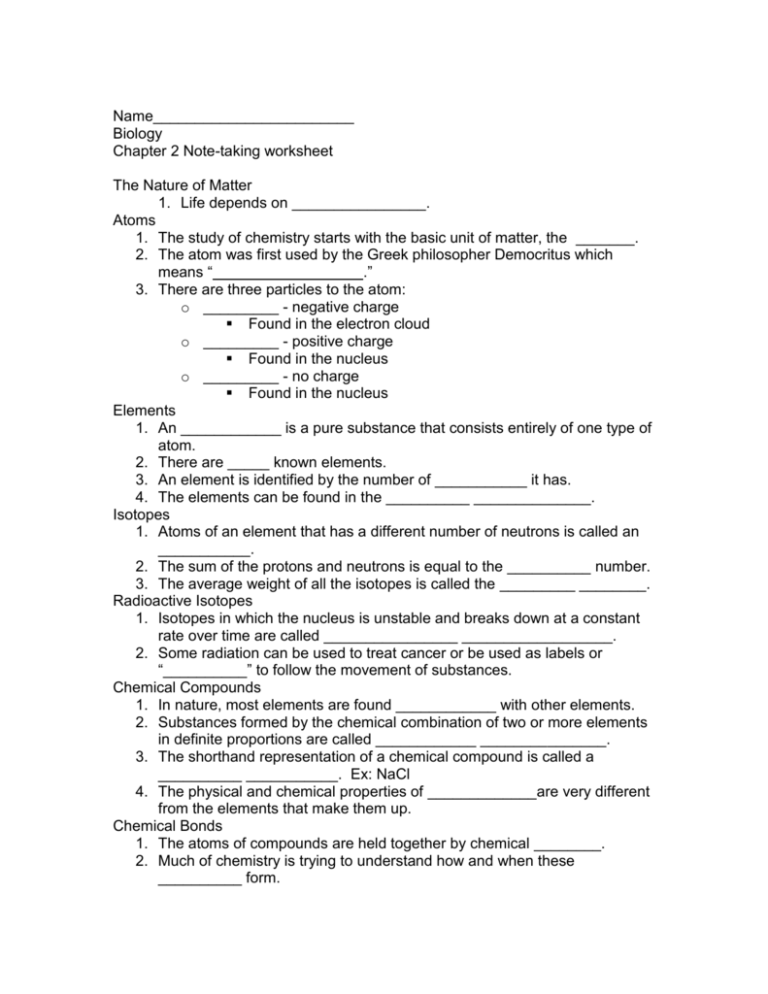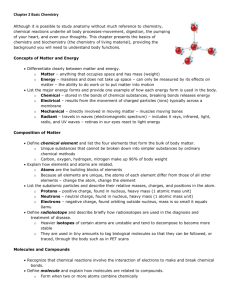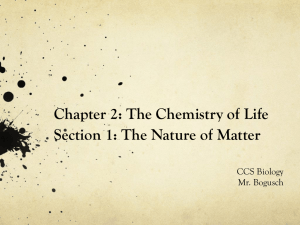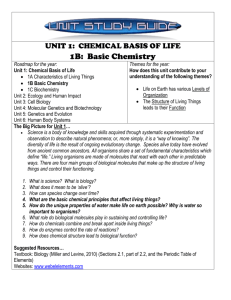Note Taking Wkst
advertisement

Name________________________ Biology Chapter 2 Note-taking worksheet The Nature of Matter 1. Life depends on ________________. Atoms 1. The study of chemistry starts with the basic unit of matter, the _______. 2. The atom was first used by the Greek philosopher Democritus which means “ .” 3. There are three particles to the atom: o _________ - negative charge Found in the electron cloud o _________ - positive charge Found in the nucleus o _________ - no charge Found in the nucleus Elements 1. An ____________ is a pure substance that consists entirely of one type of atom. 2. There are _____ known elements. 3. An element is identified by the number of ___________ it has. 4. The elements can be found in the __________ ______________. Isotopes 1. Atoms of an element that has a different number of neutrons is called an ___________. 2. The sum of the protons and neutrons is equal to the __________ number. 3. The average weight of all the isotopes is called the _________ ________. Radioactive Isotopes 1. Isotopes in which the nucleus is unstable and breaks down at a constant rate over time are called ________________ __________________. 2. Some radiation can be used to treat cancer or be used as labels or “__________” to follow the movement of substances. Chemical Compounds 1. In nature, most elements are found ____________ with other elements. 2. Substances formed by the chemical combination of two or more elements in definite proportions are called ____________ _______________. 3. The shorthand representation of a chemical compound is called a __________ ___________. Ex: NaCl 4. The physical and chemical properties of _____________are very different from the elements that make them up. Chemical Bonds 1. The atoms of compounds are held together by chemical ________. 2. Much of chemistry is trying to understand how and when these __________ form. 3. The bond formation is the responsibility of the __________of each atom. 4. The electrons that form the bonds are called ___________ electrons. 5. The two types of chemical bonds are __________ bonds and _________ bonds. Ionic Bonds 1. An __________bond is formed when one or more electrons are transferred from one atom to another. 2. In a neutral state, the number of electrons is equal to the number of____________. 3. In ionic bonds, the atom that lost the electron has a positive charge and the atom that gained the electron has a negative charge. Covalent Bond 1. A covalent bond forms when the electrons of two or more atoms are __________ between the atoms 2. Types of covalent bonds: a. Single bond: sharing of two electrons b. Double bond: sharing of four electrons c. Triple bond: sharing of six electrons 3. The structure that results when atoms are joined together by covalent bonds is called a ______________. Van der Waals Forces 1. Because of their structures, atoms of different elements do not all have the same ability to ___________electrons. 2. When atoms of a covalent bond share electrons, the sharing is not always___________. 3. If the sharing of the electrons is equal, the rapid movement of the electrons can create regions on a molecule that have tiny positive or negative charges. 4. When molecules are close together, a slight attraction can develop between the oppositely charged regions of the nearby____________. 5. These intermolecular forces of attraction are called _______________________ forces. Geckos 1. Geckos show a great example of van der Waals forces. 2. A geckos foot is covered by as many as half a million tiny hair-like projections. 3. Each projection is further divided into hundreds of tiny, flat-surface fibers. 4. This design allows a great area of the geckos’ foot to attract forces with the atoms of the surface they are walking on. Properties of Water 1. Water covers __/__of Earth’s Surface. 2. __________ is the single most abundant compound in most living things. The Water Molecule • Water is a neutral molecule, but is considered to be_____________. • The oxygen atom has a stronger attraction for electrons than the hydrogen. • Therefore the electrons spend more time around the oxygen atom. • This gives the oxygen atom a negative charge and the hydrogen atoms a positive charge. • A water molecule is polar because there is an uneven distribution of ______________ between the oxygen and hydrogen atoms Hydrogen Bonds 1. Because the water molecule is polar, it has a positive and ________ side. 2. The positive charge of one molecule attracts to the negative charge of another molecule. 3. This attraction forms a _____________ bond. 4. Hydrogen bonds are weaker than ionic or covalent bonds. 5. These hydrogen bonds are responsible for many of water’s properties. Cohesion 1. ____________ is the attraction between molecules of the same substance. 2. Water molecules can form as many as four __________ bonds at the same time. 3. Water’s cohesion causes molecules on the surface to be drawn inward, which is why drops of water form beads on a smooth surface. 4. This cohesion makes it possible for insects to walk across the surface of a pond or lake. Adhesion 1. ____________is the attraction between molecules of different substances. 2. Example: Water in graduated cylinder a. At eye level, the water tends to ______ in the middle. b. This is because the adhesion between the water and the glass molecules is stronger than the cohesion of the water molecules. 3. _____________ action -the ability of water rise in a narrow tube against the force of gravity Solutions and Suspensions 1. Water is often found as part of a____________. 2. A mixture is a material composed of two or more __________or __________that are physically mixed together but not chemically combined. 3. Two types of mixtures that could be made with water are __________and __________. Solutions 1. The components of a solution are __________distributed. 2. A solution is made up of two components. a. __________ - the substance that is dissolved. b. __________ - the substance in which the solute dissolves. 3. The best solvent in the world is _________. 4. Example: Salt water a. When a crystal of salt is placed in water, sodium and chloride ions on the surface of the crystal are attracted to the polar water molecules. b. Ions break away from the crystal and are surrounded by water molecules. Suspensions 1. Some materials do not dissolve when placed in water but separate into pieces so small that they do not settle out. 2. The movement of the water molecules keep the small particles __________. 3. This mixture of water and nondissolved material is called a ___________. 4. Example: a. Blood: Blood is mostly made up of water, but contains blood cells that remain suspended as the blood travels through your body. Acids, Bases, and pH • Water is a _________ molecule, but also has the ability to form into ions. • The following chemical equation demonstrates the reactions: • Only about 1 in 550 million molecules of water react to form an ion. pH Scale 1. Scientist developed a scale to determine the concentration of H+ ions in a solution. 2. It is called the ___ scale and it ranges from 0 to 14. 3. At 7, the number of H+ ions is equal to the number of OH- ions. 4. Below 7, there are more H+ ions than OH- ions, which means the solution is__________. 5. Above 7, there are more OH- ions than H+ ions, which means the solution is __________. 6. Each step on the pH scale represents a factor of 10. Acids 1. An ________ is any compound that forms H+ ions in a solution. 2. Acidic solutions contain higher concentrations of H+ ions than pure water and have pH values below ____. Bases 1. A ________ is a compound that produces OH- ions in solution. 2. Basic, or alkaline, solutions contain lower concentrations on H+ ions than pure water and have pH values above ____. Buffers 1. A __________ is a weak acid or base that can react with strong acids or bases to prevent sharp, sudden changes in pH. 2. Buffers are important because the cell must remain at a pH between 6.5 and 7.5. 3. If the pH goes beyond this range, the __________ _________ that take place may be affected. The Chemistry of Carbon 1. __________chemistry is the study of molecules that contain the atom carbon. 2. The carbon atom is an extremely important element. 3. Carbon contains ____ valence electrons. 4. It has the ability to form __________bonds with many different elements such as hydrogen, oxygen, phosphorus, sulfur, nitrogen, and even another carbon atom. 5. Because carbon has the ability to bond to another carbon, it can form long chains, form single, double, and triple bonds, and close upon itself for form rings. Macromolecules 1. The term _____________ means “giant molecules.” 2. Macromolecules are formed by small, organic compounds, called __________, joined together through the process called polymerization. 3. The final product of this process is a __________. 4. There are four groups of organic compounds found in living things: a. ______________ b. ______________ c. __________ __________ d. ______________ Carbohydrates 1. ____________are made up of carbon, hydrogen, and oxygen in a 1:2:1 ratio. 2. They are used by living things as the main source of __________. 3. The immediate supply of energy for all cell activities comes from __________. 4. Extra glucose is stored as a complex carbohydrate known as __________. 5. The formula for glucose is __________________. 6. A __________ sugar molecule is called a monosaccharide. 7. Examples include glucose, galactose (milk), and fructose (fruit). 8. The large macromolecules are called ______________. 9. In animals, it is called glycogen, animal starch. 10. In plants, it is called __________, which is used to give plants its strength. Lipids 1. __________ are molecules that are not soluble in water. 2. They consist of __________, __________, and __________. 3. Lipids can be used to store __________. 4. Some lipids are important parts of biological membranes and waterproof coverings. 5. Lipids are formed when a glycerol molecule combines with three fatty acids. 6. There are two types of lipids: a. Saturated - Contain maximum number of hydrogens. b. Unsaturated - There is at least one double bond between the carbons. Nucleic Acids 1. __________ acids are macromolecules made up of hydrogen, oxygen, nitrogen, carbon, and phosphorus. 2. The monomer that make up a nucleic acid is called a __________. 3. A nucleotide has three parts: a. ______________ b. ______________ group c. ______________ base 4. Nucleic acids store and transmit hereditary, or __________, information. 5. There are two types of nucleic acids: a. Ribonucleic Acid (________) b. Deoxyribonucleic Acid (________) Proteins 1. __________ are macromolecules that are made up of nitrogen, carbon, hydrogen, and oxygen. 2. The monomer of a protein is called an __________ acid. a. Amino acids have a amino group (-NH2) on one end and a carboxyl group (-COOH) on the other. 3. There are 20 different amino acids, which make up all known __________. Chemical Reactions 1. __________ reaction is a process that changes, or transforms, one set of chemicals into another. 2. Mass and energy are __________ during chemical transformations. 3. The elements or compounds that enter into a chemical reaction are known as __________. 4. The elements or compounds produced by a chemical reaction are __________. 5. Chemical reactions always involve changes in the chemical bonds that join atoms in compounds. Energy in Reactions 1. Chemical reactions either release or absorb energy. 2. Chemical reactions that release energy often occur spontaneously. 3. Chemical reactions that absorb energy will not occur without a source of energy Activation Energy 1. In order to get a reaction to start, a certain amount of __________ must be applied to the reactants. 2. The energy needed to start a chemical reaction is called __________ energy. Enzymes 1. Some reactions that are important to living things are too _______ or have activation energies that are too _______. 2. They still happen because the cell has the ability to make its own __________ (a substance that speeds up reactions) which lower the activation energy. 3. __________ are proteins that act as biological catalysts. Characteristics of Enzymes 1. Enzymes are very specific to the __________ (reactants) they bind to. 2. Enzymes are often named by adding the suffix “-_______” to some part of the name of the substrates. 3. Enzymes do not change and are reusable.







